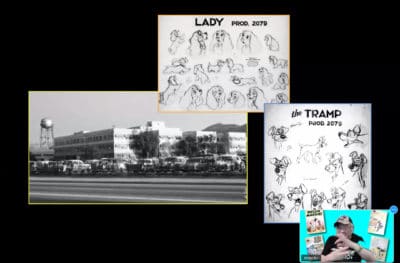
The Walt Disney Family Museum had a presentation with Willie Ito, a Japanese-American former Disney and Hanna-Barbera animator who was interned in the US internment camps during WWII. The presentation was hosted by Mindy Johnson and part of a series about WWII Japanese artists with another presentation coming next month.
Willie Ito discussed with Mindy Johnson about what it was like to be suddenly taken to an internment camp during WWII. At the time, America had great prejudice against the Japanese because of the bombing of Pearl Harbor, and forcefully placed citizens of Japanese descent into relocation camps in fear. Ito said he was just eight years old when he and his family were taken to the camp. Conditions were not the greatest, to say the least, as the lodge-like homes they were placed in had no insulation. Johnson brought up that almost 2000 out of the about 120,000 incarcerated died from medical problems suffered within the camp. Also pointed out was that 1 out of 10 of those were from tuberculous.
Despite the challenges from the camp, Ito discussed how he kept developing his art. This was after, at age five, he saw Snow White and the Seven Dwarves in the theater and decided that animation is what he wanted to do. He did point out that he thought Walt Disney did every single drawing for the Disney company.
Eventually, he made his way through school with even a high school that had a cartooning class. Making his way from the Northern California Bay Area and to the now called Art Center college, he studied art and was able to have a meeting at the Walt Disney Studio. Though he showed his portfolio, he wasn’t accepted at that time. Later he was brought in to take a “test” of drawing. From there he was hired to Disney animation without even graduating art school yet!
Willie Ito’s first assignments were on Lady and the Tramp. He was tasked with working on Lady and especially the key scenes of eating with Tramp. Iwao Takamato, another Japanese animator at Disney helped get Ito in and helped him develop as an animator.
Eventually, both Ito and Takamato went to Hanna-Barbera as animators. Though Takamato was a mentor, Ito regarded him as a close friend as well. After working at Hanna-Barbera for some time, Ito was asked by Disney to go back to the studio as an artist. He told a story of working in the comic strip area of the company and given a script to work on. He admitted to procrastinating for so long that he got a phone call a day before having to present 5 pages worth of material the next day. He promptly got to work all night and presented it.
Ito shared many great stories such as those about his time as an animator. He worked on Golden Books, animated films, and under many of the great animators we’ve known for a long time. He noted how the animation world was not one of prejudice, that it was about the skill of the artist and not the ethnicity. Both he and Takamato were accepted based on their portfolio. Mindy Johnson chimed in with a story about how Walt Disney helped Gyo Fujikawa escape internment during WWII. Walt knew it would be coming, and helped her and family move to New York to escape incarceration. It was told that Walt Disney would actually call from time to time and ask how all things were and to make sure that they were taken care of there.
Ito is a delightful artist to hear from. He has been working on a new animated short though he’s been retired. A book he produced called Hello Maggie is popular in the European markets and becoming an animated production very soon. He worked on more illustrations for it and is adding a new scene to his book because of it. The book has also had another iteration in Boy From Heart Mountain, which is inspired by the experience of someone at that camp, which also happens to be the camp that my grandmother was incarcerated during WWII.
For that reason, I greatly enjoyed the presentation. Not only is Ito an artist we rarely hear about who has contributed so much to the animation world, but we also learn about a period of history that was challenging for an ethnic group. It still is coming up in today’s times as California only just apologized in February 2020 for racial prejudice of its part in internment camps during WWII. Besides the history of WWII, there were delightful anecdotes about how detailed in-betweeners had to be for animated films. Other stories included how outlandish the animators dressed back in that day (perhaps something that hasn’t changed today). It was a remarkably unique interview of a skilled animator.
there were delightful anecdotes about how detailed in-betweeners had to be for animated films. Other stories included how outlandish the animators dressed back in that day (perhaps something that hasn’t changed today). It was a remarkably unique interview of a skilled animator.
There is a chance to hear about another Japanese-American interned animator named Ruth Asawa in September through the Walt Disney Family Museum. I would greatly encourage everyone to purchase a pass for the virtual presentation on waltdisney.org. I’m sure it will be as great as this presentation was and full of interesting histories of both America and animation!






